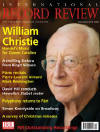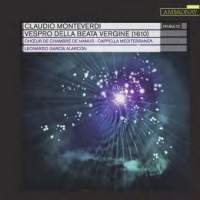Texte paru dans: / Appeared in:
*

International Record Review - (12//2014)
Pour
s'abonner / Subscription information
Ambronay
AMY041

Code-barres / Barcode : 3760135100415
Consultez toutes les évaluations recensées pour ce cd
~~~~ Reach all the evaluations located for this CD
Does Claudio Monteverdi's Vespro della Beata Vergine of 1610 form a complete and coherent liturgical cycle? The French musicologist Denis Morrier thinks not, even though he regards the whole as a musical masterpiece. For Morrier, who contributed the main booklet essay for Leonardo Garcia Alarcón's recording of the work, this 'enigmatic composition' and 'inexhaustible masterpiece' is not intended as a whole for any specific liturgical office but is a compilation of works originally composed for different occasions. Although the 1610 Vespers contains the introductory versicle, five psalms, hymn and Magnificat (in two alternative versions) required for the vespers service on a Marian feast day, Morrier points out that the diverse modes of the psalms’ plainchant cantus firmi, around which Monteverdi wove a sumptuous synthesis of Renaissance polyphony and modern concertante writing, does not accord with any known vespers office for the Blessed Virgin Mary or any other female saint.
Perhaps it is better not to attempt to perform the work in a liturgical reconstruction, but to see the Vespers as a kind of product sample book Monteverdi intended to display to potential patrons and employers the artistry and workmanship he could bring to their commissions, as Morrier's countryman Lionel Desmeules suggests in his programme notes. This might explain the presence in the 1610 publication of the massive Palestrinian stile antico Missa 'In illo tempore', the two alternative versions of the Magnificat, and the four extra‑liturgical one‑, two‑ and three-voice concerti with basso continuo (Nigro sum, Pulchra es, Duo seraphim and Audi coelum) and Sonata sopra 'Sancta Maria' inserted after each psalm apparently to replace the repetition of the plainchant antiphons traditionally sung before and after each psalm during vespers.
Despite this, Desmeules and Garcia Alarcón have created their own antiphon cycle for a liturgical performance of the Vespers, setting the antiphon texts for vespers on the feast of the Nativity of the Blessed Virgin Mary to newly composed plainchant melodies matching the plainchant tones Monteverdi used in the psalms ‑ an interesting and potentially musically satisfying endeavour if rather unnecessary. Yet, here Garcia Alarcón missteps, for, in an effort to seek a more seventeenth‑century 'declamatory' style and avoid any nineteenth‑century Solesmes‑style 'piety' and 'sentimentalism' (though it has been a long time since I have heard Solesmes-style chanting in any early Baroque music recordings), he has the tenors and basses of the Chamber Choir of Namur sing these new antiphons in coarsened, quasi‑Byzantine voices with touches of Eastern‑sounding ornamentation based on the somewhat eccentric theories of Marcel Pérès. Would not Monteverdi's contemporaries have sung their plainchant in the same way as their polyphony and concerted music, possibly even with some improvised Italianate ornamentation?
Thankfully, the antiphons are separately tracked and can be skipped or programmed out during playback.
Unfortunately, the eccentricities of this recording do not stop at the plainchant. Once again, seeking a more declamatory expression in Monteverdi's music, Garcia Alarcón directs a weirdly unsettled performance of the work by his vocal soloists, choir (implausibly large for Monteverdi's time) and instrumentalists. Tempos lurch constantly from one extreme to the other, almost phrase by phrase, always just too fast or slow and often at the expense of an overall tactus. Meanwhile, passages of full‑throated choral singing usually melt suddenly into moments of extreme quietness. The effect is initially arresting with the unusually fast‑paced opening and contrasting dynamics of the choir in the versicle Deus in adjutoriumIDomine in adjuvandum, but quickly pales with the realization the performance is never going to settle down. It is almost as if Garcia Alarcón has set out to do the opposite of everyone else who has recorded the work. The constant push‑me‑pull‑you of his abrupt rallentandos and diminuendos and bursts of high speed and volume are exhausting and quite lacking in subtlety. Not even the constant of the cantus firmus can overcome the fractured effect of Garcia Alarcón's direction on most of the psalms.
On the whole, the solo singing is less peculiar than the choral passages. The two sopranos, Céline Scheen and Mariana Flores, are in excellent voice in the duet Pulchra es, accompanied by florid lutes and harp. Although not given to the same exaggerated phrasing as the choir, the principal tenor, Fernando Guimaraes, often lapses into an intrusive, bleating vibrato, both in the wonderful Nigro sum for solo tenor and his solo passages in the ensemble pieces. The other tenor solo with echo, Audi coelum, is sung with refinement by two baritones (no reason is given for not using tenors), but the replacement of the third tenor with a baritone in Duo Seraphim disturbs Monteverdi's carefully balanced textures.
On the choral front, things settle down a little bit in the Sonata sopra 'Saneta Maria' and the Ave Maris Stella hymn. In the former, the tempo finally relaxes, allowing the violins and cornetts to indulge in flourishing ornamentation. Garcia Alarcón uses the hymn's stately ritornello very attractively as an instrumental introduction, with , recorders joining violins, viols, lutes and harp. Delightfully, one of the ritornellos between the verses is also given to the solo harp.
Even the sound engineering is problematic on this recording. It was made in the very resonant abbey church of Ambronay and the tenors and basses are often pushed too forward while the rest of the choir and the instruments are distant. The usually penetrating cornetts and trombones, often sound recessed also. I cannot recall another .
disc where one dare not let go of the remote control, as constant adjustment is needed to maintain a comfortable listening volume, which is exacerbated by Garcia Alarcón's extreme dynamic shifts.
There
are undeniably beautiful moments in this recording: the singing of the two
sopranos, some brilliant violin and Cornett playing and an exceptionally
attractive continuo contribution. But overall, this is a desperately
disappointing recording of Monteverdi's masterpiece.
Fermer la fenêtre/Close window
Cliquez l'un ou l'autre
bouton pour découvrir bien d'autres critiques de CD
Click either button for many other reviews


